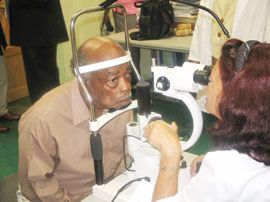45 EYEING CUBA

Some 45 Vincentians who have suffered with various eye diseases such as cataracts left for Cuba yesterday at 1:30 p.m. hoping to return with a better view of the world. Literally!
This comes as the government of Cuba has fast-tracked an initiative to assist Vincentians who suffer eye-related illnesses.{{more}}
The first batch of persons diagnosed since the Cuban team of Drs. Maritza Miquele and Ileana Agramonte began testing on Monday was due to leave Thursday for Havana for treatment.
Only two weeks ago, Prime Minister Dr. Ralph Gonsalves announced to local media that Cuba’s President Dr. Fidel Castro had offered assistance with the setting up of a screening and diagnostic center for eye diseases here in St. Vincent and the Grenadines.
Soon after Dr. Gonsalves’ announcement, a Cuban emissary Dr. Juane Laria, special advisor to Dr. Castro arrived here to examine facilities that would accommodate the expected team of medical personnel and to make arrangements for their arrival.
The team arrived at least four days ahead of the anticipated time and saw three Cuban professionals arriving on Sunday 17, with diagnostic equipment, ready to get on with the job.
Spokesman Florentino Batista told the media briefing that President Dr. Fidel Castro had undertaken this as a special project following discussions with Prime Minister Dr. Gonsalves. He explained that the specialists would be here “for as long as it takes.”
Dr. Douglas Slater, Minister of Health and the Environment explained Monday that the programme of screening for patients with cataracts and other eye diseases would begin almost immediately with the first stop being, by coincidence Clare Valley, located in the constituency the minister represents.
He explained that patients would be screened, problems identified and, if necessary, the patients transported to Cuba at a cost to be borne totally by the government of Cuba.
Pressed for a costing for each patient, neither Batista nor Dr. Slater could immediately give one. The minister guestimated however that the cost per patient for the entire treatment, including airfare and accommodation in Cuba, could be in the region of EC$12,000.
Dr Slater said that the intention was to have a mobile unit set up in a vehicle, which would move around the country carrying out the testing and diagnostic procedures. He made a link with the government’s programme of Universal Secondary Education and noted that the programme will envisage the testing of students for visual defects which often affects the academic performance of students.
Dr. Slater was supported by his permanent secretary Verlene Saunders who explained that this was a national programme which would also include, as a starting point, the children involved in Ministry of Education’s remedial programme targeted at students about to enter secondary school.
The programme will later on embrace all other students entering secondary school.
Since the Cubans began testing and diagnosis on Monday a total of 366 persons have been tested. The team also conducted sessions in North Leeward at Rose Hall and Troumaca.
Wednesday saw the team move to the Ministry of Health and the Environment in Kingstown, where many more persons were tested.
Among the prominent persons tested were former minister of education Alphonzo Dennie who suffers from cataract related problems and Prime Minister Dr. Ralph Gonsalves.
Similar projects are in train for St. Kitts and Nevis, Antigua/Barbuda and Grenada.
The pilot project was first done between Cuba and the Bolivarian Republic of Venezuela, where it was called the Miracle Eye programme, which resulted in more than 30,000 persons benefiting from this free health care. Batista said his country wanted to extend the programme to “the entire Caribbean family.”
Health care is free in Cuba where it is considered a right.









